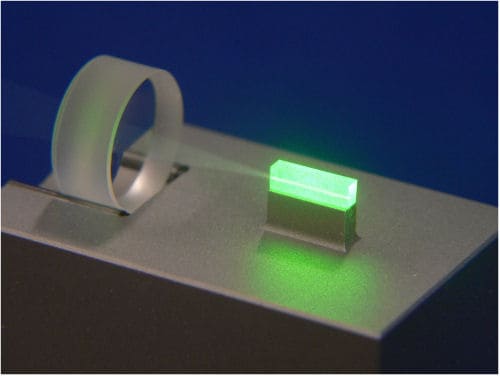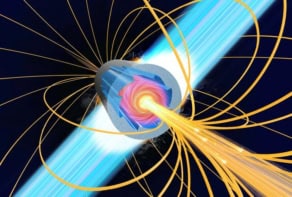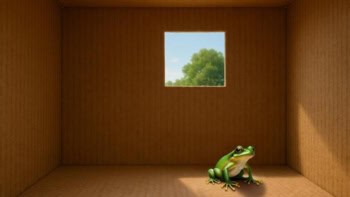
Physicists in Germany have produced a beam of “squeezed” laser light with a record low level of quantum noise. Their technique reduced the noise in an infrared beam by 90% and could someday be used to allow gravitational wave detectors to probe deeper into space and to create quantum information and cryptography systems.
The electric field of a light beam always carries some inherent quantum noise — the result of fluctuations in amplitude and phase caused by the intrinsic quantum nature of the photons. Now Roman Schnabel and colleagues at the Max Planck Institute for Gravitational Physics and Leibniz University in Hanover have found a way to remove much of this noise from a 1064-nm laser beam using a double-refraction crystal and green laser light (Phys Rev Lett 100 033602).
Storing photons
“The green laser prepares the crystal by causing the electron cloud of the crystal’s atoms to oscillate with the frequency of the green light,” explained Schnabel. “In this state, the crystal can then store photons sent in by the infrared beam.” When the photon flux is then reduced these stored photons are replaced back into the beam, which in turn achieves a more regular photon distribution.
As a result, phase fluctuations are almost eliminated from the beam. “We achieved a quantum noise reduction level of 90%,” said Schnabel, adding, “Until now a good result was a reduction by a factor of four, down to 25%”.
The researchers believe that the squeezing strength in their set-up is limited by optical losses rather than phase fluctuations, and so could be improved further.
Using squeezed light we can extend the reach of gravitational wave detectors by a factor of three Roman Schnabel, Max Planck Institute for Gravitational Physics and Leibniz University
Quantum noise can perturb sensitive measurements, such as those made by the Laser Interfermometer Gravitational Wave Observatory (LIGO) facilities in the US. All current LIGO detectors use infrared lasers to search for the tiny interference patterns that are predicted to appear when gravitational waves interact with the beams, but the extreme weakness of the waves makes them almost impossible to detect.
According to Schnabel, the uniform intensity of squeezed light could make these detectors more sensitive and allow it to probe deeper into space where the elusive waves are created. “Using squeezed light we can extend the reach of gravitational wave detectors by a factor of three,” he said.
Another application could be quantum information and cryptography. “Squeezed states have been used to demonstrate several quantum information protocols, construct entangled states of light and demonstrate quantum teleportation,” said Schnabel.


